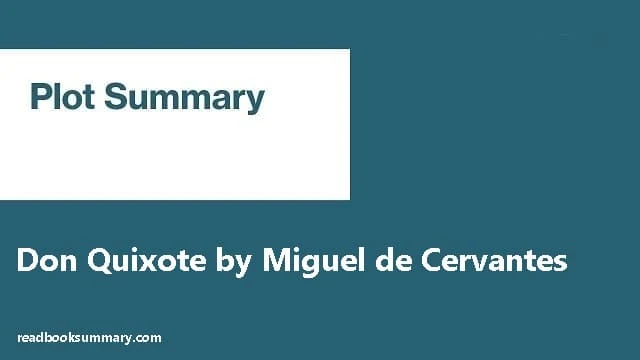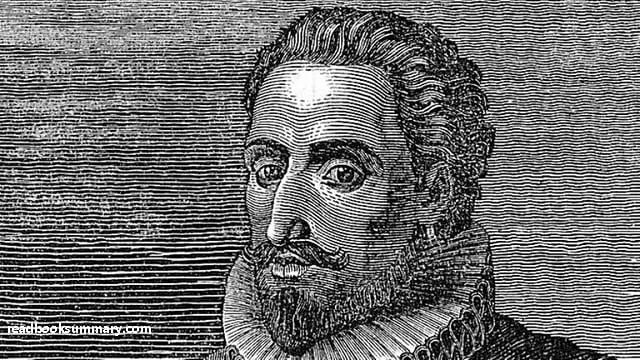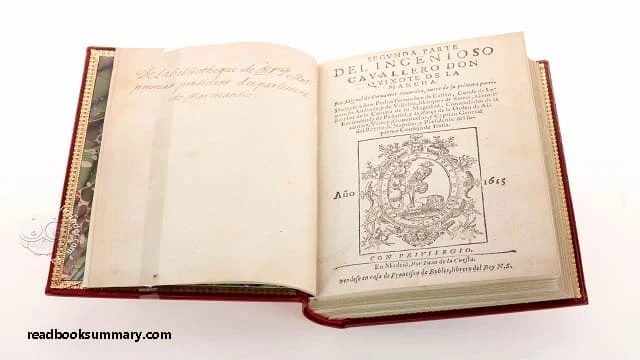Don Quixote Summary, it is a Spanish epic novel by Miguel de Cervantes. It was originally published in two parts, in 1605 and 1615. Considered a founding work of Western literature, it is often labelled as the first modern novel and one of the greatest works ever written. Don Quixote is also one of the most-translated books in the world and one of the best-selling novels of all time.
 |
| Don Quixote Book Summary |
Don Quixote Summary
Alonso Quixano is an unremarkable low-ranking member of the Spanish nobility. He lives in La Mancha in the center of Spain. As he approaches 50, he becomes bored of his life and decides to become more like the brave knights errant he reads about in his favorite books. Taking up a lance and making himself a suit of armor, he swears to challenge evildoers and protect the helpless. His niece and his housekeeper are unimpressed.
He sets out on an adventure but is immediately hurt. When he returns home, he recruits a local peasant named Sancho Panza to be his squire on the promise that Alonso will make him rich and powerful. Alonso renames himself Don Quixote and names his horse Rocinante and sets out again in search of adventure. He proclaims he will achieve great glory in the name of Dulcinea del Toboso, the name he invents for a local peasant woman whom he has never met but whom he decides is a beautiful princess.
With Panza by his side, Quixote’s second adventure is more successful. However, he retains delusions about the state of the world. He challenges befuddled people to duels and tries to charge a group of windmills with his lance, believing that they are giants. He mistakes inns for castles and delivers confusing speeches on the importance of chivalry and honor.
When he defeats a confused man in a duel, he wears the man’s bronze washbasin on his head, believing that it is a glorious helmet that once belonged to a famous knight. When he mixes a magical healing potion based on a recipe he has memorized from his books, Quixote and Panza take the medicine and become very ill. Despite this behavior, Quixote’s reputation grows, and Panza becomes increasingly loyal and devoted to his confused master.
Quixote’s story is interspersed with the tales and legends he hears on his travels. He listens to people read from novels while he stays at inns, and he hears gossip and folklore from the shepherds and goatherds who populate the area. Many of these stories involve tragic and farcical love, beautiful women, and men who become utterly obsessed with the objects of their affection.
During this time, Quixote frees a group of men who have been sentenced to be slaves on a galley (who later rob him), he reunites a lovelorn couple who believed they would never be together, and he smashes apart the contents of an inn, completely convinced he is fighting against an evil giant.
Panza’s devotion to his master moves beyond simple promises of fame and fortune. While he is initially unsure of his master’s delusions, he becomes more convinced that Quixote may be right about the world. He tries at first to correct Quixote’s mistakes but becomes increasingly lost in a romantic unreality, just like his master. Whenever anything does not go according to plan, Quixote blames evil magicians who conspire against him.
At the same time, two of Quixote’s friends try to bring his adventure to a close. Pero Perez, the priest from the village, and Master Nicholas, a local barber, try to bring Quixote back home. Eventually, they succeed in convincing Quixote the magicians have placed an enchantment on him, and they take him home, thereby ending his first adventure and the first part of the novel.
Part 2 of Don Quixote begins a short time after the end of Quixote’s earlier adventure. During this time, the narrator laments, an unscrupulous person has released a second volume of Quixote’s adventures. These stories are not authentic. As Quixote travels around Spain, he hears more and more about these fake stories. The counterfeit accounts of his deeds anger him, though he is an increasingly famous figure in the country.
Quixote convinces Panza to set out on another adventure. At the beginning of their journey, Panza tells Quixote that a magician has placed an enchantment on Dulcinea so that she appears to be an unremarkable peasant woman rather than the beautiful princess of Quixote’s delusions. Quixote scours the country for a way to undo this enchantment, even though it is entirely Panza’s invention.
A Duke and Duchess hear about Quixote and become fascinated by his absurdity. They welcome him to their home and play a series of pranks on him, using their servants to make him believe he is traveling on the back of a flying horse. The Duke even sends Panza to become the governor of an island, where the pranks planned against him clash with the local people’s surprise that Panza is a fair and wise ruler. However, Panza renounces his governorship because he does not believe he is suited for the role. He returns to Quixote.
After another series of adventures, a scholar from Quixote’s village named Sanson Carrasco succeeds in defeating him in a duel. Sanson Carrasco is allied with Master Nicholas and Pero Perez in their attempts to bring Quixote home. After being defeated in the duel, Quixote believes that he cannot claim to be a knight any longer. He returns to his home and is welcomed by his niece, his housekeeper, and his friends.
He initially plans to become a shepherd, but he soon falls ill. While lying on his deathbed, Quixote renounces his belief that he was ever a knight. He writes a will and leaves everything he has to his niece, his housekeeper, and Panza. With his death comes the death of knights errant. The narrator claims—following the death of Quixote—no more stories of chivalry will exist in the world.
 |
| Don Quixote Summary |
 |
| don quixote plot |
 |
| don quixote short summary |
 |
| don quixote synopsis |
 |
| don quixote story summary |
 |
| don quixote plot summary |
Questions about Don Quixote Plot
What is the main message of Don Quixote?
One must live life in a genuine way, passionately, in spite of what other people think. That is the central tenet of "Don Quixote," according to Professor Ilan Stavans.
What is a short summary of Don Quixote and the windmills?
Don Quixote and Sancho, mounted on a donkey, set out. In their first adventure, Don Quixote mistakes a field of windmills for giants and attempts to fight them but finally concludes that a magician must have turned the giants into windmills.
What is so special about Don Quixote?
Don Quixote is considered a prototype of the modern novel in part because its author, Miguel de Cervantes, gave voice to a vibrant assortment of characters with diverse beliefs and perspectives.
What is the biggest lesson in Don Quixote?
Our standard answer is that we do what we do because we expect it to lead to good consequences. “Quixote reminds us that there is another possible answer: We do what we do because it fulfils our identity, our sense of self.
What Don Quixote teaches us?
Don Quixote teaches us that life is to be challenged, that the passion and discipline of a willful human spirit is a vital element of being a leader. Quixote does not accept reality. He imposes his imagination, his commitment and his joy on it. He produces a world of beauty and of meaning.
What do the windmills symbolize in Don Quixote?
The windmill represents imaginary enemies. More broadly, it represents our potential for misguided fights that we romanticize or idealize in our minds.
What does Don Quixote fight against?
One of the most famous stories in the book is Don Quixote's fight with windmills. He sees some windmills and thinks they are giants. When he rides to fight with them, he is knocked off his horse.
What type of story is Don Quixote?
Don Quixote is often considered to be the first 'modern novel', establishing the genre and therefore influencing all that followed. It is a parody of romantic chivalry stories. Within the novel genre, it can be categorized as a comic novel, but also a Picaresque novel.
Why is Don Quixote worth reading?
Cervantes explores many fascinating themes whilst charting the misadventures of his two heroes, including the nature of friendship and love, virtue and vice, religious belief and, perhaps in a veiled reference to the book itself, the influence that reading can have upon our lives and imaginations.
Is Don Quixote a tragedy?
While the Romantic tradition downplayed the novel's hilarity by transforming Don Quixote into a tragic hero, readers who view it as a parody accept at face value Cervantes's intention to denounce the popular yet outdated romances of his time.
Why is Don Quixote a masterpiece?
Don Quixote was almost instantly recognized worldwide because it told a universal story. Almost every sin and deed described in the book was relatable to the simplest human living in those times and even now, in the 21st century, we still feel an affinity with a character written four hundred years ago.
What are the most important scenes in Don Quixote?
In perhaps the most famous scene from the novel, Don Quixote sees three windmills as fearful giants that he must combat, which is where the phrase “tilting at windmills” comes from. At the end of Part I, Don Quixote and Sancho are tricked into returning to their village.
How did Don Quixote influence the world?
Don Quixote has inspired many illustrators, painters and sculptors, including Gustave Doré, Pablo Picasso, Salvador Dalí and Antonio de la Gandara.
Why is the title Don Quixote?
There is no inherent meaning to the title Don Quixote. It is simply the name of the main character of the book. Don Quixote, along with Sancho Panza, his sidekick, goes through many adventures throughout Spain in order to, at least in the mind of Don Quixote, defend the laws and territory of Spain against enemies
Why and how was Don Quixote defeated?
Don Quixote and the priest meet in the Sierra Morena, and Dorothea begs for Don Quixote to help her avenge her stolen kingdom. The Second Part: Sampson, disguised as the Knight of the White Moon, defeats Don Quixote.
Why did Don Quixote fight with windmills?
In Don Quixote, the protagonist attacks the windmills because he thinks they are giants with long arms. Quixote is traveling the world to seek out and defeat injustice and finds enemies where there are none. The windmills are an example of this, probably inspired by that landmark in Holland during conflicts with Spain.
What is the reflection of Don Quixote?
Through the character of Don Quixote, Cervantes expresses his resentment of the Reconquista movement in 15th century Spain. As a truly noble and good person, Don Quixote attempts to see the world in the most positive perspective as he lives his life as the archetypical chivalric soldier, or knight.
Who is the villain in Don Quixote?
Friston The "sage enchanter" who figures as Quixote's arch-nemesis. Quixote accuses Friston of stealing his library and robbing him of a victory by transforming giants into windmills just as Quixote was on the verge of victory against them.
Is Quixote a hero or anti hero?
Don Quixote falls under the category of an antihero. He possesses deep character flaws which undermine his ability to act heroically, but he nevertheless acts with good intentions. Don Quixote has a shaky grasp on reality. He is prideful, prejudiced, and relentlessly stubborn.
Is Don Quixote Based on a true story?
Don Quixote is not a true story. Some of the confusion surrounding the novel as fiction or non-fiction stems from the real places and real historical figures with whom Don Quixote interacts. Further, Cervantes called his novel "a history," which also adds to this confusion.
Is it hard to read Don Quixote?
Don Quixote” is a very hard book to read. Most people find it intimidating and never read the whole book. The book is very long: 52 chapters in the first book, 74 in the second book. It's dense.
Is Don Quixote an irony?
Ironic. From the beginning, it is clear that Miguel de Cervantes thinks that Don Quixote's efforts to be a knight are foolish. He tells us early on, in fact, that his title character "unluckily stumbled upon the oddest fancy that ever entered into a madman's brain," which is to become a wandering knight.
How does Don Quixote die?
Don Quixote dies at the end of Part 2 of the novel. After Don Quixote and Sancho Panza return home to their village of La Mancha, Spain, Don Quixote falls ill, renounces chivalry and foolish fiction, and dies.
Who is Don Quixote’s sidekick?
Don Quixote's sidekick is his squire Sancho Panza. Sancho Panza is a short, pot-bellied peasant whose appetite, common sense, and vulgar wit serve as a foil to the idealism of his master. He is notable for his many pertinent proverbs
What is the major theme of Don Quixote?
Self-belief is easily the most pronounced theme in the whole of 'Don Quixote'. However, other themes such as insanity, literature, and human culture are applicable.
What is Don Quixote a metaphor for?
Already in the 17th century the term quixote was used to describe a person who does not distinguish between reality and imagination.
How long is Don Quixote to read?
The average reader will spend 17 hours and 52 minutes reading this book at 250 WPM (words per minute).







